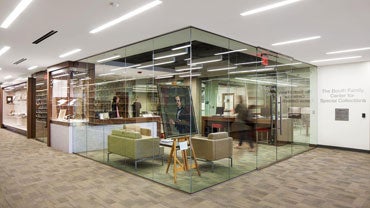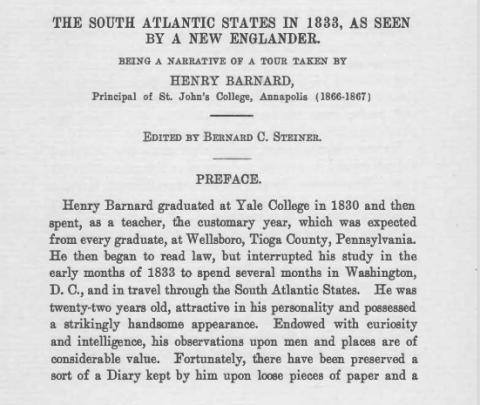
Editor’s Note: This story contains graphic descriptions of racial violence. Story posted October 25, 2022.
As a result of research from Loyola University Maryland, archivists at the Booth Family Center for Special Collections learned of a disturbing historical account of a human artifact displayed in a former museum at Georgetown.
While working with students and faculty at Loyola University Maryland, Jennifer Kinniff, head of Archives and Special Collections at Loyola Notre Dame Library, identified and sent to Georgetown archivists a copy of the diary and correspondence of Henry Barnard, a 22-year-old law student who recounted his travels to Washington, DC, and other Eastern states in 1833.
In his handwritten account, transcribed and published in a 1918 edition of Maryland Historical Magazine, Barnard described a human artifact he saw in Georgetown’s Coleman Museum: “Saw a piece of a Negro's hide tanned—it was as thick as calves skin.”

After learning of the account in July 2022, Georgetown archivists have undertaken a thorough investigation of the former Coleman Museum and its holdings. They reviewed institutional records and museum records and reached out to the Smithsonian Institution Archives, where some of the museum’s artifacts were transferred in the 1940s after the museum closed.
Following an exhaustive investigation, the archivists have found no evidence or record that the artifact was part of the university’s holdings. The museum’s inventory was known to be cataloged at least twice, in the 1890s and 1940s, and no record was found indicating the presence of the artifact. The archivists also did not find any references in historical records.
However, the lack of records does not dispute the veracity of the 1833 account, says Harriette Hemmasi, dean of the Georgetown University Library. “Even though Georgetown archivists have found no additional evidence related to this barbarous artifact encountered by Barnard in 1833, it is possible that by making this story known, future researchers will be able to trace and elucidate more of its history,” Hemmasi says.
Joe Ferrara, vice president and chief of staff in the Office of the President, expressed his sorrow and remorse in learning of Barnard’s account in the university museum.
“We are deeply saddened to learn about this painful, horrific account of the university’s past,” Ferrara says. “This is another heartbreaking example of the dehumanization perpetuated against Africans and Black Americans. We will continue to reckon with the legacies of slavery that have shaped our past and respond by advancing justice and equity in our present.”
Georgetown is committed to its engagement in a long-term and ongoing process to more deeply understand and respond to the university’s role in the injustice of slavery and the legacies of enslavement and segregation in our nation.
The Georgetown University Library continues to digitize the Archives of the Maryland Province of the Society of Jesus and publish items from before 1900 in DigitalGeorgetown, providing a valuable resource on the history of slavery and Catholic history. Library archivists have also recently improved the collection’s finding aid, enhancing the arrangement and description of the materials and making them more accessible to researchers and the general public.
A digital copy of the historical account is posted and available. Updated information about ongoing work related to research and archival materials can be found at the Library website and the Georgetown Slavery Archive.
